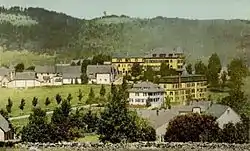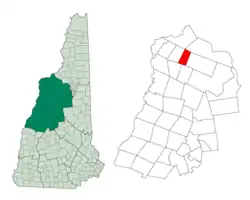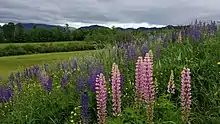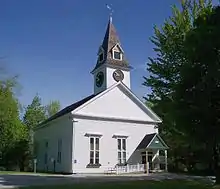Sugar Hill, New Hampshire | |
|---|---|
Town | |
 The Sunset Hill House, Sugar Hill, c. 1910 | |
 Location in Grafton County, New Hampshire | |
| Coordinates: 44°12′55″N 71°47′58″W / 44.21528°N 71.79944°W | |
| Country | United States |
| State | New Hampshire |
| County | Grafton |
| Incorporated | 1962 |
| Government | |
| • Select Board |
|
| Area | |
| • Total | 17.23 sq mi (44.63 km2) |
| • Land | 17.05 sq mi (44.16 km2) |
| • Water | 0.18 sq mi (0.47 km2) 1.06% |
| Elevation | 1,325 ft (404 m) |
| Population (2020)[2] | |
| • Total | 647 |
| • Density | 38/sq mi (14.7/km2) |
| Time zone | UTC-5 (Eastern) |
| • Summer (DST) | UTC-4 (Eastern) |
| ZIP code | 03586 |
| Area code | 603 |
| FIPS code | 33-74740 |
| GNIS feature ID | 0873730 |
| Website | www |
Sugar Hill is a town in Grafton County, New Hampshire, United States. The population was 647 at the 2020 census,[2] an increase over the figure of 563 tabulated in 2010.[3] The town overlooks the White Mountain National Forest, with views of the Presidential, Franconia, Kinsman and Dalton ranges. Sugar Hill was incorporated as a town in 1962, the most recent in New Hampshire.
History

Incorporated in 1962 out of the town of Lisbon after considerable litigation, Sugar Hill is the most recently incorporated town in the state. The name "Sugar Hill" comes from the large groves of sugar maples within the town limits.
Offering clean air and panoramic views from atop Sunset Hill Ridge of both the White Mountains and Green Mountains, the community became a fashionable Victorian resort. First attracted by paintings of White Mountain artists, the wealthy arrived by train to escape the heat, humidity and pollution of summers in Boston, Hartford, New York and Philadelphia. Several hostelries were built, including the Hotel Lookoff. But the grandest was the Sunset Hill House, built in 1880 after rail service arrived in neighboring Lisbon Village (Sunset Hill Station). With the longest porch on a single side in New Hampshire, the Second Empire hotel accommodated 350 guests and 300 staff. Patrons found amusement in the casino and bowling alley, or on carriage rides touring nearby Franconia Notch. Built in 1897, the 9-hole Sugar Hill House Golf Course, together with its 1900 clubhouse, are the oldest in the state and are listed on the National Register of Historic Places. Bobby Jones played the links.
With the advent of automobiles came a decline in grand hotels, however, as tourists were no longer restricted by the limits of rail service. The Sunset Hill House remained open until 1973, longer than many of its type in the region. But it closed at season's end, when the furnishings were sold at auction. The aging structure was demolished in 1974, although its annex survived and was purchased in 2013 by new owners, to reopen in 2015 as "The Inn at Sunset Hill".

Peckett's-on-Sugar Hill
Robert P. Peckett Sr. acquired land on Sugar Hill around 1900 and founded the Peckett's-on-Sugar Hill Inn.[4] While hosting winter guests early in the century, the need for increased clientele prompted him, with the assistance of his daughter, Katherine "Kate" Peckett, to establish the first resort-based ski school in the United States.[5] The first two ski instructors were German; they introduced the Arlberg technique developed by Hannes Schneider at St. Anton. In 1931, Sig Buchmayr joined the staff. Kate Peckett brought in several more European instructors including Otto Lang to teach the Arlberg system. Among pupils were Nelson Rockefeller, Averell Harriman, Lowell Thomas, Minot Dole and Roger Peabody.[6] Subsequent efforts by Kate, the CCC and others resulted in the development of the Taft Ski Trail and other facilities on the Cannon Mountain Ski Area.[7]
Image gallery
 Sunset Hill House c. 1906
Sunset Hill House c. 1906 Mount Lafayette from Sugar Hill in 1913
Mount Lafayette from Sugar Hill in 1913 Carriage ride c. 1905
Carriage ride c. 1905 Green Mountains from Sugar Hill c. 1920
Green Mountains from Sugar Hill c. 1920
Geography
According to the United States Census Bureau, the town has a total area of 17.2 square miles (44.6 km2), of which 17.1 square miles (44.2 km2) are land and 0.2 square miles (0.5 km2) are water, comprising 1.06% of the town.[1] Sugar Hill is drained by the Gale River and other tributaries of the Ammonoosuc River, part of the Connecticut River watershed. The town is crossed by New Hampshire Route 117. Interstate 93 and New Hampshire Route 18 pass through the northeastern corner of the town. The highest point in Sugar Hill is the summit of Bronson Hill, at 2,078 feet (633 m) above sea level, in the southwestern corner of the town.
Demographics
| Census | Pop. | Note | %± |
|---|---|---|---|
| 1970 | 336 | — | |
| 1980 | 397 | 18.2% | |
| 1990 | 464 | 16.9% | |
| 2000 | 563 | 21.3% | |
| 2010 | 563 | 0.0% | |
| 2020 | 647 | 14.9% | |
| U.S. Decennial Census[2][8] | |||

As of the census[9] of 2000, there were 563 people, 258 households, and 164 families residing in the town. The population density was 32.9 inhabitants per square mile (12.7/km2). There were 385 housing units at an average density of 22.5 per square mile (8.7/km2). The racial makeup of the town was 98.40% White, 1.24% Asian, and 0.36% from two or more races. Hispanic or Latino of any race were 0.18% of the population.
There were 258 households, out of which 22.1% had children under the age of 18 living with them, 56.2% were married couples living together, 4.7% had a female householder with no husband present, and 36.4% were non-families. 29.8% of all households were made up of individuals, and 12.0% had someone living alone who was 65 years of age or older. The average household size was 2.18 and the average family size was 2.72.
In the town, the population was spread out, with 18.1% under the age of 18, 5.3% from 18 to 24, 24.2% from 25 to 44, 33.7% from 45 to 64, and 18.7% who were 65 years of age or older. The median age was 46 years. For every 100 females, there were 98.9 males. For every 100 females age 18 and over, there were 101.3 males.
The median income for a household in the town was $49,219, and the median income for a family was $60,288. Males had a median income of $36,667 versus $25,714 for females. The per capita income for the town was $29,743. About 4.3% of families and 5.3% of the population were below the poverty line, including none of those under age 18 and 10.6% of those age 65 or over.
Notable people
- Bette Davis (1908–1989), actress (summer visitor)[10]
- Ernest Poole (1880–1950), novelist
- Potter Stewart (1915–1985), Associate Justice of the United States Supreme Court[11]
- Harlan Fiske Stone (1872–1946), Chief Justice of the United States[12]
- William C. Sullivan (1912–1977), FBI agent, killed in a hunting accident on November 9, 1977, in Sugar Hill
- Mary Parker Woodworth (1849–1919), writer, speaker
Sites of interest
- New Hampshire Historical Marker No. 73: First Ski School in America
- Polly's Pancake Parlor, a James Beard Foundation American Classic
References
- 1 2 "2021 U.S. Gazetteer Files – New Hampshire". United States Census Bureau. Retrieved November 30, 2021.
- 1 2 3 "Sugar Hill town, Grafton County, New Hampshire: 2020 DEC Redistricting Data (PL 94-171)". U.S. Census Bureau. Retrieved November 30, 2021.
- ↑ "Geographic Identifiers: 2010 Demographic Profile Data (G001): Sugar Hill town, Grafton County, New Hampshire". U.S. Census Bureau, American Factfinder. Archived from the original on February 12, 2020. Retrieved February 6, 2014.
- ↑ Memories of Peckett's Inn, #11 New England Ski Museum 1984
- ↑ New Hampshire and the Emergence of an American Ski Industry, November 10, 2009, by Jeffrey R. Leich, New England Ski Museum
- ↑ http://skiinghistory.org/history/timeline-important-ski-history-dates
- ↑ "Cannon Mountain, New Hampshire - New England's Alpine CCC Ski Trails".
- ↑ "Census of Population and Housing". Census.gov. Retrieved June 4, 2016.
- ↑ "U.S. Census website". United States Census Bureau. Retrieved January 31, 2008.
- ↑ "Bette Davis Eyes Sugar Hill". March 2012.
- ↑ "Stewart, an Ex-Justice, Hospitalized by Stroke". The New York Times. December 7, 1985.
- ↑ Alpheus Mason, Harlan Fiske Stone, 1956, p. 658
